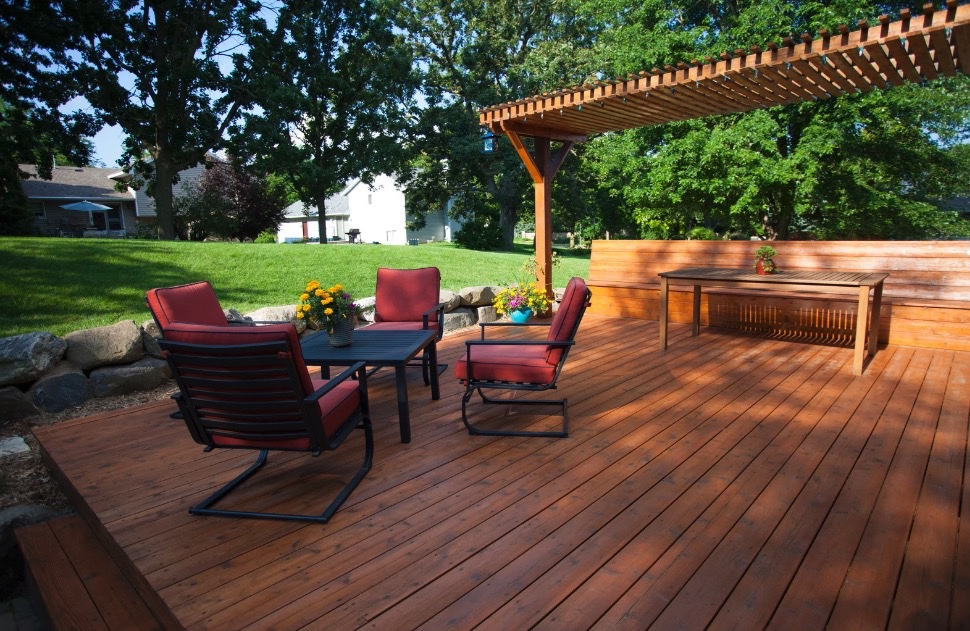Wood Decking vs. Composite Decking in 2025
In 2025, homeowners looking to upgrade their outdoor spaces have more choices than ever when it As homeowners continue to invest in outdoor living, the demand for functional and stylish decks remains high in 2025. One of the most important decisions you’ll face when planning a deck is the material—wood or composite. Each option has evolved in recent years, offering more choices, colors, and performance features than ever before.
So how do you decide between the natural appeal of wood and the durability of composite? Let’s break down the differences to help you make the best choice for your lifestyle and budget.
Why Wood Decking Is Still a Top Choice in 2025
For those who love the beauty of organic materials, wood decking continues to deliver. It’s been the go-to for generations—and it’s not going anywhere.
One of the biggest advantages of wood decking is its authenticity. There’s something about real wood grain, the way it weathers over time, and the feel under your feet that composite simply can’t replicate. Whether you choose pressure-treated pine, cedar, or redwood, wood decking offers a natural warmth that’s hard to beat.
Another reason homeowners stick with wood decking is its flexibility. It’s easy to stain, cut, and shape to fit your exact design goals. You can change the look over time with new finishes, or blend the deck into your landscaping for a cohesive backyard aesthetic. If creativity and craftsmanship matter to you, wood decking gives you more control over the final result.

Wood decking is also generally more budget-friendly upfront. While long-term maintenance is a factor, the initial installation cost is often lower than composite, which appeals to many homeowners who want to add value to their home without breaking the bank.
Repairs are also simpler with wood decking. If a board gets damaged, it can be swapped out without disrupting the entire deck structure—something not always possible with composite systems.
That said, wood decking does require consistent care. Colorado’s intense sun, snow, and seasonal moisture mean your deck will need staining and sealing every couple of years to prevent warping, fading, or insect damage. But for those who don’t mind the upkeep—or who enjoy the annual refresh—wood decking continues to offer timeless value.
Why Composite Decking Is on the Rise
Composite decking has made major strides in both performance and appearance. In 2025, it’s no longer just the “low-maintenance” alternative—it’s a sleek, modern solution built to last.
Unlike wood decking, composite decking doesn’t require staining, sealing, or refinishing. That’s a huge win for homeowners who don’t want to spend time or money on upkeep. A quick rinse or light scrub is usually all it takes to keep composite boards looking sharp.
Durability is where composite really shines. These boards are engineered to resist mold, moisture, and insect damage. They won’t splinter or rot, and they’re highly resistant to fading—especially newer-generation composites that use protective caps and UV-resistant materials.
It is also a more sustainable option than many people realize. Most products are made from a mix of recycled plastic and reclaimed wood fibers. So not only do you get a long-lasting deck, but you’re reducing waste and supporting circular manufacturing.
Design-wise, composite offers a wide range of colors and textures. You can get the look of exotic hardwoods or bold contemporary styles—all without worrying about weather damage or refinishing.
However, this convenience comes at a cost. Composite decking often carries a higher price tag upfront than wood decking. And while it doesn’t require yearly maintenance, it’s not as easy to customize or repair. If a composite board is damaged, replacing it may require specific tools—or even contacting the manufacturer.
Another factor to consider is heat. On hot summer days, this decking can retain more warmth than wood decking, which may be uncomfortable in direct sun. Choosing lighter colors or adding shade structures can help mitigate this.
How to Decide Between Wood Decking and Composite Decking
In the decking debate of 2025, the choice ultimately comes down to your personal preferences, budget, and maintenance expectations. Both options offer distinct advantages and considerations. It also depends on how you plan to use the space, how much maintenance you’re comfortable with, and what kind of visual impact you’re going for.
If you love the look and feel of natural materials, enjoy design flexibility, and are okay with a bit of annual maintenance, wood decking is a beautiful and rewarding choice. It’s also ideal if you want to work within a tighter budget or prefer to make repairs over time.
If convenience, durability, and long-term performance are your top priorities, composite decking offers a hassle-free solution that’s built for modern living. It’s perfect for homeowners who want a great-looking deck without the seasonal upkeep.
Let SNS Construction Bring Your Deck Vision to Life
Whatever material you choose, the key to a successful deck is a professional installation. At SNS Construction, we’ve been building stunning outdoor spaces for Colorado homeowners for years, and we understand what it takes to design a deck that lasts through sun, snow, and everything in between.
Whether you’re leaning toward the classic appeal of wood decking or the innovation of composite, we’re here to guide you through the process, answer your questions, and create a space you’ll love for years to come.
Ready to build? Get in touch with SNS Construction today and let’s start planning your perfect deck.
